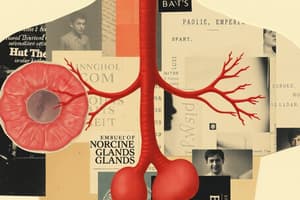Podcast
Questions and Answers
A/an ______ is an organ whose cells secrete materials to be brought to different regions in the body via tubelike structures called 'ducts'.
A/an ______ is an organ whose cells secrete materials to be brought to different regions in the body via tubelike structures called 'ducts'.
gland
______ glands secrete hormones directly into either the bloodstream or the fluid around the cells.
______ glands secrete hormones directly into either the bloodstream or the fluid around the cells.
Ductless
The term 'exo' in exocrine glands means ______, referring to the way these glands deliver substances.
The term 'exo' in exocrine glands means ______, referring to the way these glands deliver substances.
outward
______ mechanisms detect and adjust the amount of hormones in circulation or the amount of other chemicals produced by an initial hormone reaction
______ mechanisms detect and adjust the amount of hormones in circulation or the amount of other chemicals produced by an initial hormone reaction
If an increased hormone secretion is enhanced to produce even more hormones, it's called a/an ______ feedback mechanism
If an increased hormone secretion is enhanced to produce even more hormones, it's called a/an ______ feedback mechanism
A/an ______ feedback mechanism counteracts the production of more hormones
A/an ______ feedback mechanism counteracts the production of more hormones
Hormones only affect ______ cells or organs, ensuring specific and localized responses
Hormones only affect ______ cells or organs, ensuring specific and localized responses
______ are destroyed in the liver after they have performed their function.
______ are destroyed in the liver after they have performed their function.
The process by which ductless glands secrete hormones directly into the bloodstream or fluid around cells is called ______ secretion.
The process by which ductless glands secrete hormones directly into the bloodstream or fluid around cells is called ______ secretion.
The production of each hormone must be the ______ amount for the body to function correctly.
The production of each hormone must be the ______ amount for the body to function correctly.
Flashcards
What is a gland?
What is a gland?
An organ whose cells secrete materials via tubelike structures called ducts.
What are endocrine glands?
What are endocrine glands?
Glands that secrete hormones directly into the bloodstream or fluid around cells.
What are exocrine glands?
What are exocrine glands?
Glands that deliver substances through ducts; examples include sweat, mucus, and salivary glands.
What are feedback mechanisms?
What are feedback mechanisms?
Signup and view all the flashcards
What is a positive feedback mechanism?
What is a positive feedback mechanism?
Signup and view all the flashcards
What is a negative feedback mechanism?
What is a negative feedback mechanism?
Signup and view all the flashcards
How do hormones work?
How do hormones work?
Signup and view all the flashcards
How are hormones removed?
How are hormones removed?
Signup and view all the flashcards
When are hormones secreted?
When are hormones secreted?
Signup and view all the flashcards
How much hormones must be produced?
How much hormones must be produced?
Signup and view all the flashcards
Study Notes
- A gland includes cells which secrete materials.
- Tubelike structures called "ducts" bring these materials to different regions in the body.
Endocrine Gland
- Endo means “within”.
- Krinein means “separate”.
- Endocrine glands are ductless.
- These glands secrete hormones directly into the bloodstream or the fluid around the cells.
Exocrine Gland
- Exo means “outward”.
- Exocrine are glands that deliver substances through ducts.
- Examples of exocrine glands include sweat glands, mucus glands, and salivary glands.
Functions of Hormones
- Some glands do not function until the organism reaches a certain age, so some hormones are not secreted until then.
- Short-term and long-term hormones are different.
- The correct amount of each hormone must be produced.
- Hormones only affect their target cells or organs.
- Hormones are broken down in the liver after completing their function.
How Hormones Work
- Secreting cells release hormones.
- The hormones enter the blood stream to be transported
- The hormones exit the blood stream to enter the target cell
Hormone Regulation
- Feedback mechanisms detect and adjust the amounts of hormones in circulation or the amount of other chemicals produced by an initial hormone reaction.
- A positive feedback mechanism enhances increased hormone secretion to an even greater amount.
- Negative feedback mechanisms counteract further hormone production.
Negative Feedback Mechanism
- Carbohydrates are broken down into glucose.
- Glucose entering the blood stream will trigger the release of insulin
- Insulin allows glucose to move from the blood stream into cells
- Once inside the cells, glucose converted into glycogen for energy/storage
Negative Feedback Mechanism
- When blood glucose levels drop, the Pancreas releases Glucagon
- Glucagon causes Glycogen in the cell to be broken down into Glucose
- Glucose leaving the cell will enter the blood stream
- Glucose flowing in the bloodstream can then be used for energy
Studying That Suits You
Use AI to generate personalized quizzes and flashcards to suit your learning preferences.




